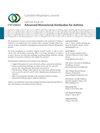Effect of Tiotropium Bromide on Airway Inflammation and Programmed Cell Death 5 in a Mouse Model of Ovalbumin-Induced Allergic Asthma
IF 2.1
4区 医学
Q3 RESPIRATORY SYSTEM
引用次数: 7
Abstract
Rationale We previously demonstrated increased expression of programmed cell death 5 (PDCD5) in asthmatic patients and ovalbumin-induced allergic asthma. International guidelines (GINA 2019) have included the use of tiotropium bromide for chronic treatment of the most severe and frequently exacerbated asthma in patients ≥6 years old, who do not have good response to inhaled corticosteroids. Objective To explore the role of tiotropium and its effect on PDCD5 level in a mouse model of chronic asthma. Methods We divided 12 female mice into 2 groups: untreated asthma (n = 6) and tiotropium-treated asthma (n = 6). The impact of tiotropium was assessed by histology of lung tissue and morphometry. Pulmonary function was tested by using pressure sensors. The number of cells in bronchoalveolar lavage fluid (BALF) was detected. Levels of PDCD5, active caspase-3, and muscarinic acetylcholine receptors M2 (ChRM2) and M3 (ChRM3) were examined. Results Tiotropium treatment significantly reduced airway inflammation and remodeling in asthmatic mice and intensified the lung function. PDCD5 level was reduced with tiotropium (p < 0.05). Moreover, active caspase-3 level was decreased with tiotropium (p < 0.001), and ChRM3 level was increased. Conclusions Tiotropium treatment may alleviate the pathological changes with asthma by regulating apoptosis.噻托溴铵对卵清蛋白致过敏性哮喘小鼠气道炎症和程序性细胞死亡的影响
理由我们先前证明,程序性细胞死亡5(PDCD5)在哮喘患者和卵清蛋白诱导的过敏性哮喘中的表达增加。国际指南(GINA 2019)包括使用噻托溴铵慢性治疗对吸入皮质类固醇反应不佳的≥6岁患者中最严重和最常加重的哮喘。目的探讨噻托溴铵在慢性哮喘小鼠模型中的作用及其对PDCD5水平的影响。方法将12只雌性小鼠分为2组:未经治疗的哮喘组(n = 6) 噻托溴铵治疗哮喘(n = 6) 。通过肺组织学和形态计量学评估噻托溴铵的影响。使用压力传感器检测肺功能。检测支气管肺泡灌洗液(BALF)中的细胞数量。检测PDCD5、活性胱天蛋白酶-3和毒蕈碱乙酰胆碱受体M2(ChRM2)和M3(ChRM3)的水平。结果噻托溴铵治疗可显著减轻哮喘小鼠气道炎症和重塑,增强肺功能。噻托溴铵可降低PDCD5水平(p<0.05),噻托溴胺可降低活性胱天蛋白酶-3水平(p<0.001),ChRM3水平升高。结论噻托溴铵治疗可通过调节细胞凋亡来减轻哮喘的病理变化。
本文章由计算机程序翻译,如有差异,请以英文原文为准。
求助全文
约1分钟内获得全文
求助全文
来源期刊

Canadian respiratory journal
医学-呼吸系统
CiteScore
4.20
自引率
0.00%
发文量
61
审稿时长
6-12 weeks
期刊介绍:
Canadian Respiratory Journal is a peer-reviewed, Open Access journal that aims to provide a multidisciplinary forum for research in all areas of respiratory medicine. The journal publishes original research articles, review articles, and clinical studies related to asthma, allergy, COPD, non-invasive ventilation, therapeutic intervention, lung cancer, airway and lung infections, as well as any other respiratory diseases.
 求助内容:
求助内容: 应助结果提醒方式:
应助结果提醒方式:


